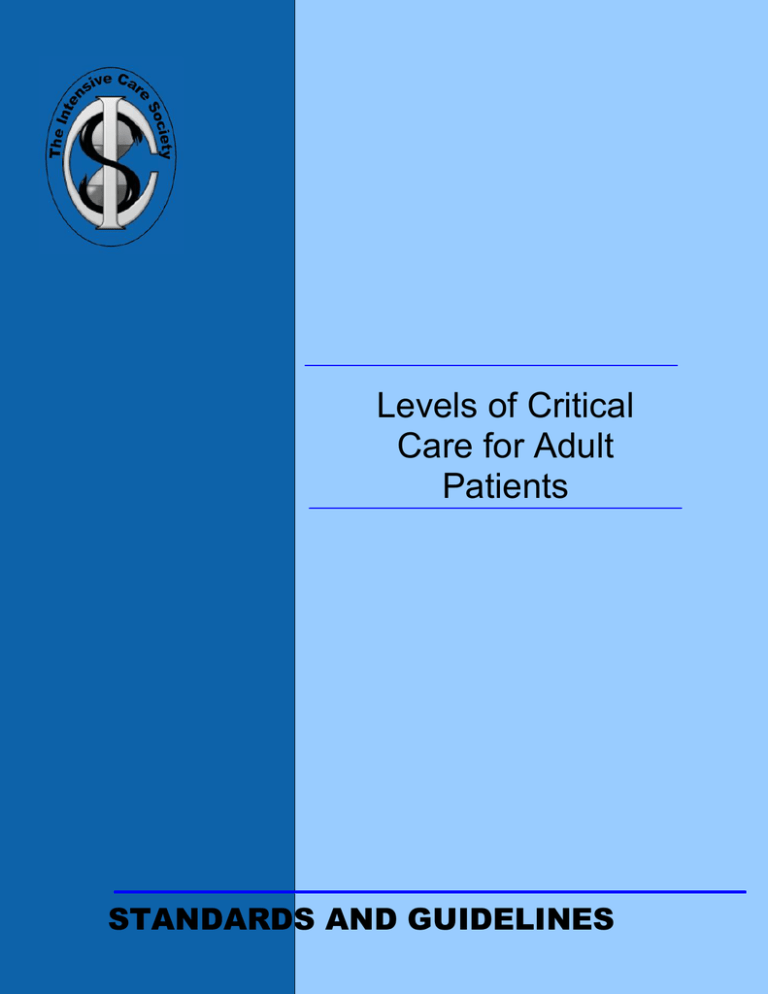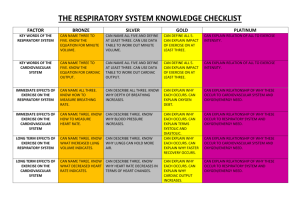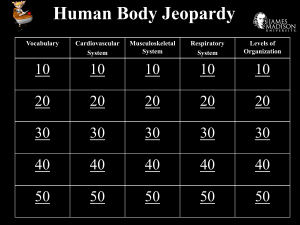
LEVELS OF CARE
Levels of Critical
Care for Adult
Patients
STANDARDS AND GUIDELINES
INTENSIVE CARE SOCIETY STANDARDS © 2009
1
LEVELS OF CARE
2
Intensive Care Society © 2009
All rights reserved. No reproduction, copy or transmission of this publication may be made
without written permission. No paragraph of this publication may be reproduced, copied or
transmitted save with written permission or in accordance with the provisions of the Copyright,
Designs and Patents Act 1988 or under the terms of any licence permitting limited copying
issued by the Copyright Licensing Agency, 80 Tottenham Court Road, London W1P 0LP.
Neither the Intensive Care Society nor the authors accept any responsibility for any loss or
damage arising from actions or decisions based on the information contained within this
publication. Ultimate responsibility for the treatment of patients and interpretation of the published
material lies with the medical practitioner. The opinions expressed are those of the authors and
the inclusion in this publication of material relating to a particular product or method does not
amount to an endorsement of its value, quality, or the claims made by its manufacturer.
Prepared on behalf of the Council of the Intensive Care Society by:
Dr J Eddleston Manchester Royal Infirmary
Dr D Goldhill Royal National Orthopaedic Hospital, Stanmore
Dr J Morris Chair Critical Care Information Advisory Group
INTENSIVE CARE SOCIETY STANDARDS © 2009
LEVELS OF CARE
Contents
1.
Introduction
2.
General principles
3.
Definition of Levels of Care
INTENSIVE CARE SOCIETY STANDARDS © 2009
3
LEVELS OF CARE
4
Introduction
This document describes the levels of care required by critically ill patients in
hospital. It specifically does not comment on, or recommend, staffing
establishments or skill mix in relation to each level, nor does the level of care
relate to an individual patient‟s Critical Care HRG as defined by the Critical Care
Minimum Dataset1 (CCMDS). It follows the approach of allocating levels of care
to patients according to their clinical needs and disregards location or the
prevailing nurse to patient ratio.
The definitions were originally developed after the publication of Comprehensive
Critical Care2 in 2000, published in 20023, and latterly revised to reflect the
Critical Care Minimum Dataset1 (CCMDS) which has been mandated since April
2006. The dataset supports the introduction of 'Payment by Results' into Critical
Care by linking clinical interventions for critically ill patients to remuneration of
activity and has recently revised several of the organ failure definitions.
This document has been agreed with the Critical Care Stakeholders' Forum and
the Department of Health through the Critical Care Information Advisory Group
(CCIAG), and should be regarded as the standard for data collection until further
notice. Updates will be notified via the ICS website.
INTENSIVE CARE SOCIETY STANDARDS © 2009
LEVELS OF CARE
5
General Principles
Clinical judgement should be used to determine which level of care would be
most appropriate based on the criteria below.
Although a lower level of care will usually require a lower nurse to patient ratio or
reduced critical care support, this may not apply in all circumstances and the aim
should be to be flexible in the provision of staff resources to meet the needs of
the patient. The level of care assigned to a patient will influence, but not
determine, staffing requirements.
The location of patients does not determine their level of care.
Patients who have „not for resuscitation‟ orders written or who are receiving
palliative care may also fulfil the criteria listed below. It may be appropriate to
modify the actual level of critical care delivered to these patients whilst enhancing
their palliative care.
The examples in the right hand column are provided to assist and are not
intended to be exhaustive or prescriptive.
INTENSIVE CARE SOCIETY STANDARDS © 2009
LEVELS OF CARE
6
Definition of Levels of Care
Level 0 Criteria
Requires hospitalisation
Needs can be met through normal ward care.
INTENSIVE CARE SOCIETY STANDARDS © 2009
Examples
Intravenous therapy.
Observations required less frequently
than 4 hrly.
LEVELS OF CARE
Level 1 Criteria
Examples
Patients recently discharged from a
higher level of care
Patients requiring a minimum of 4 hrly
observations.
Patients in need of additional
monitoring/clinical interventions,
clinical input or advice
Patients requiring critical care
outreach service support
INTENSIVE CARE SOCIETY STANDARDS © 2009
Requiring a minimum of 4 hrly
observation on the basis of clinical
need.
Requiring continuous oxygen therapy.
Boluses of intravenous fluid (need not
determined by CVP).
Epidural analgesia or Patient
Controlled Analgesia in use.
Parenteral nutrition.
Postoperative surgical patients who
are still requiring 4 hrly observations.
Requiring administration of bolus
intravenous drugs through a Central
Venous Catheter.
With a tracheostomy.
With a chest drain in situ.
Requiring a minimum of 4 hourly GCS
assessment.
With diabetes receiving a continuous
infusion of insulin.
Who are at risk of aspiration
pneumonia.
On established intermittent renal
support.
Requiring respiratory physiotherapy to
treat or prevent respiratory failure.
Requiring frequent (> 2x day) Peak
Expiratory Flow rate measurement for
clinical reasons.
Abnormal vital signs but not requiring
a higher level of critical care.
Risk of clinical deterioration and
potential need to step up to level 2
care. Patients fulfil the “medium” risk
category as defined by NICE
Guideline No: 50.
7
LEVELS OF CARE
8
Level 2 Criteria
Examples
Patients needing pre-operative
optimisation
Cardiovascular, renal or respiratory
optimisation required prior to surgery.
(Invasive monitoring inserted to assist
optimisation (arterial line, and CVP as
a minimum)).
Patients needing extended
postoperative care
Immediate care following major
elective surgery.
Emergency surgery in unstable or
high risk patients.
Where there is a risk of postoperative
complications or a need for enhanced
interventions and monitoring.
Patients stepping down to Level 2
care from Level 3
Requiring a minimum of hourly
observations.
At risk of deterioration and requiring
level 3 care again.
Patients receiving single organ support
(exceptions: Basic Respiratory and Basic Cardiovascular Support
occurring simultaneously without any other organ support should be
considered as Level 2 and Advanced Respiratory Support alone is
Level 3).
Indicated by one or more of the following:
Patients receiving Basic
Respiratory Support
(NB: When Basic Respiratory and
Basic Cardiovascular support are
provided at the same time during
the same critical care spell and no
other organ support is required, the
care is considered to be Level 2
care)
INTENSIVE CARE SOCIETY STANDARDS © 2009
Mask / hood CPAP or mask / hood Bilevel positive airway pressure (noninvasive ventilation)
Patients who are Intubated to protect
the airway but needing no ventilatory
support
CPAP via a tracheostomy
More than 50% oxygen delivered by
face mask. (Note, more than 50% has
been chosen to identify the more
seriously ill patients in a hospital).
Short-term increases in FiO2 to
facilitate procedures such as transfers
or physiotherapy do not qualify.
Close observation due to the potential
for acute deterioration to the point of
needing advanced respiratory support.
(e.g. severely compromised airway or
deteriorating respiratory muscle
function).
LEVELS OF CARE
Physiotherapy or suction to clear
secretions at least two hourly, whether
via tracheostomy, minitracheostomy,
or in the absence of an artificial airway
Patients who are recently (within 24
hours) extubated after a period
(greater than 24 hours) of mechanical
ventilation via an endotracheal tube.
NB: The presence of a tracheostomy used
for long term airway access only does not
qualify for basic respiratory support.
Patients receiving Basic
Cardiovascular Support
(NB: When Basic Respiratory and
Basic Cardiovascular support are
provided at the same time during
the same critical care spell and no
other organ support is required the
care is considered to be Level 2
care)
Patients receiving Advanced
Cardiovascular Support
(NB: Basic Cardiovascular support
will frequently occur prior to
Advanced Cardiovascular support
and should not lead to both
Advanced Cardiovascular support
and Basic Cardiovascular support
being recorded at the same
calendar day. Advanced
Cardiovascular support supersedes
Basic Cardiovascular support
where this occurs.)
INTENSIVE CARE SOCIETY STANDARDS © 2009
Indicated by one or more of the following:
Use of a CVP line for monitoring of
central venous pressure and /or
provision of central venous access to
deliver titrated fluids to treat
hypovolaemia.
Use of an arterial line for monitoring
the arterial pressure and/or sampling
of arterial blood.
Single intravenous vasoactive drug
used to support or control arterial
pressure, cardiac output or organ
perfusion.
Single/multiple intravenous rhythm
controlling drug(s) to support or
control cardiac arrhythmias
Indicated by one or more of the following:
Multiple intravenous vasoactive and/or
rhythm controlling drugs when used
simultaneously to support or control
arterial pressure, cardiac output or
organ / tissue perfusion, (e.g.
inotropes, amiodarone, nitrates). To
qualify for advanced support status, at
least one drug needs to be
vasoactive.
Continuous observation of cardiac
output and derived indices (e.g.
pulmonary artery catheter, lithium
dilution, pulse contour analyses,
oesophageal Doppler, impedance and
conductance methods).
Intra aortic balloon pumping and other
assist devices.
Insertion of a temporary cardiac
pacemaker (criteria valid for each day
of therapeutic connection to a
9
LEVELS OF CARE
Patients receiving Renal Support
Patients receiving Neurological
Support
Patients receiving Dermatological
Support
INTENSIVE CARE SOCIETY STANDARDS © 2009
10
functioning external pacemaker unit)
Indicated by:
Acute renal replacement therapy
(e.g.haemodialysis, haemofiltration
etc.) or
provision of renal replacement therapy
to a chronic renal failure patient who
is requiring other acute organ support
in a critical care bed.
Indicated by one or more of the following:
Central nervous system depression
sufficient to prejudice the airway and
protective reflexes, excluding that
caused by sedation prescribed to
facilitate mechanical ventilation or
poisoning (e.g. deliberate or
accidental overdose, alcohol, drugs
etc.).
Invasive neurological monitoring or
treatment e.g. ICP, jugular bulb
sampling, external ventricular drain.
Continuous intravenous medication to
control seizures and / or continuous
cerebral monitoring.
Therapeutic hypothermia using
cooling protocols or devices
Indicated by one or more of the following
Patients with major skin rashes,
exfoliation or burns. (e.g. greater than
30% body surface area affected).
Use of complex dressings (e.g. large
skin area greater than 30% of body
surface area, open abdomen, vacuum
dressings or, large trauma such as
multiple limb or limb and head
dressings).
LEVELS OF CARE
Level 3 Criteria
Patients receiving Advanced
Respiratory Support alone
(NB: Basic Respiratory support will
frequently occur prior to Advanced
Respiratory support and should not
lead to both Advanced Respiratory
support and Basic Respiratory
support being recorded at the same
calendar day. Advanced
Respiratory support supersedes
Basic Respiratory support where
this occurs.)
OR
Patients receiving a minimum of 2
organs supported
Examples
Indicated by one of the following:
Invasive mechanical ventilatory
support applied via a trans-laryngeal
tracheal tube or applied via a
tracheostomy.
Bi-level positive airway pressure
applied via a trans-laryngeal tracheal
tube or applied via a tracheostomy
CPAP via a trans-laryngeal tracheal
tube.
Extracorporeal respiratory support.
Examples:
(NB: Basic Respiratory and Basic
Cardiovascular do not count as 2
organs if they occur simultaneously
(see above under Level 2 care), but
will count as Level 3 if another
organ is supported at the same
time)
INTENSIVE CARE SOCIETY STANDARDS © 2009
Basic Respiratory and Neurological
support.
Basic Respiratory and Hepatic
Support.
Basic Respiratory and Renal
support.
Basic Cardiovascular and Hepatic
support.
Basic Cardiovascular and Renal
support.
Advanced Cardiovascular and Renal
support.
Advanced Cardiovascular and
Hepatic support.
Advanced Cardiovascular and
Neurological support.
11
LEVELS OF CARE
References
1. Critical Care Minimum Dataset.
2. Comprehensive Critical Care: a review of adult critical care services.
Department of Health May 2000
3. Intensive Care Society. Levels of Critical Care for Adult Patients 2002.
INTENSIVE CARE SOCIETY STANDARDS © 2009
12


